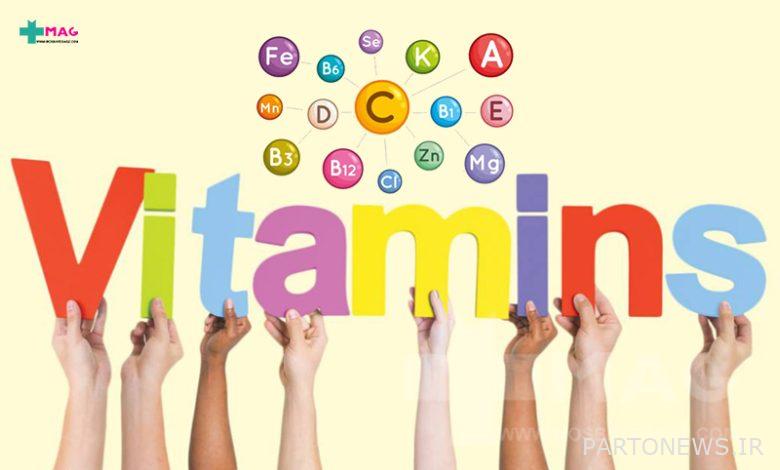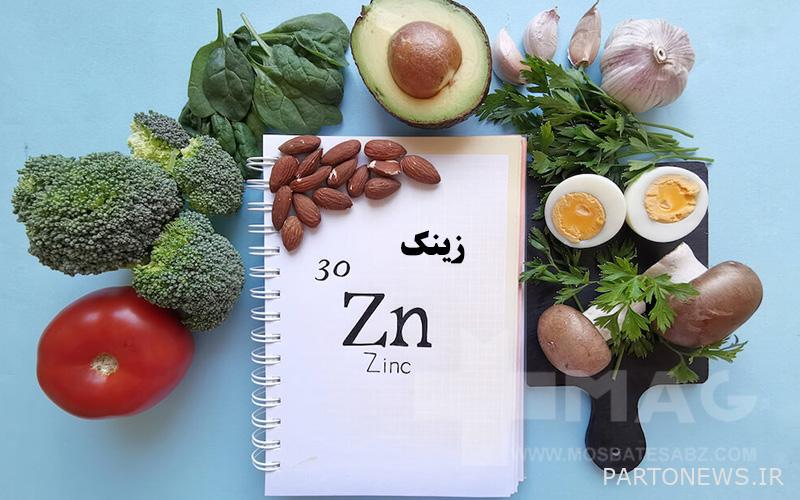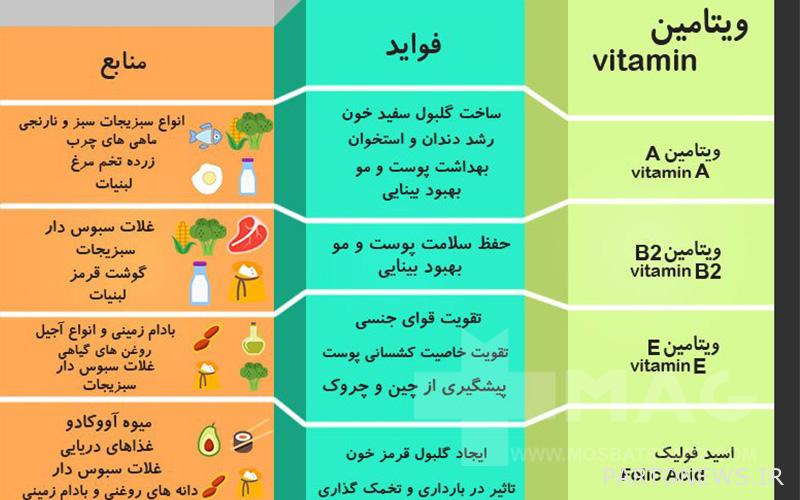What vitamins and minerals does the body need?

Healthy eating and avoiding the factors that have a negative impact on your health will provide you with all the vitamins and minerals. But unfortunately, many of us do not have a healthy diet and we are not as diligent in maintaining our health as we should be. One of the factors that has made taking multivitamin and mineral pills more and more popular every day is related to unhealthy nutrition and so-called malnutrition. In this article, we will introduce you to the vitamins and minerals your body needs. We will also tell you how much to use each of them.
What we read in this article
What is a vitamin?
Vitamins are organic compounds found in natural foods. If the level of a vitamin in the body decreases, the risk of various diseases will increase. Vitamins are actually organic compounds; This means that they contain carbon. There are a total of 13 known vitamins that can be obtained through eating food. Fruits and vegetables are the best sources of vitamins for the body.
What are minerals?
Minerals are elements found in soil or food that the human body needs to perform its natural functions. In English, a mineral is called a mineral. With the help of multivitamin and mineral pills, it is possible to help supply the body with both vitamins and minerals. A more natural way to provide these nutrients to the body is to have a healthy and varied diet.
Introducing the vitamins and minerals needed by the body
In this section, we will first introduce the vitamins needed by the body and then we will go to the minerals (minerals):
Vitamin A
It is a fat-soluble vitamin and has an antioxidant role.
Function: Essential for the immune system, vision and cell growth.
Complications of vitamin A deficiency: night blindness and keratomalacia.
Symptoms of vitamin A deficiency: night blindness, dry eyes, irritated skin, stunted growth, weakened immune system.
Sources of vitamin A: Liver, fish liver oil, carrots, broccoli, eggs, spinach, pumpkin.
| Age | Dosage in men (micrograms) | Dosage in women (Micrograms) | pregnancy period | Breastfeeding |
| From birth to 6 months | 400 | 400 | ||
| 7 to 12 months | 500 | 500 | ||
| 1 to 3 years old | 300 | 300 | ||
| 4 to 8 years old | 400 | 400 | ||
| 9 to 13 years old | 600 | 600 | ||
| 14 to 18 years old | 900 | 700 | 750 | 1200 |
| 19 to 50 years old | 900 | 700 | 770 | 1300 |
| 51 years and older | 900 | 700 |
Vitamin B1
There are 8 B vitamins, one of which is vitamin B1. All of these vitamins are water soluble.
Chemical name: Thiamine
Function: Essential for the production of various enzymes that help break down blood sugar.
Complications of Vitamin B1 Deficiency: Berry Berry and Wernicke-Korsakoff Syndrome
Symptoms of vitamin B1 deficiency: loss of appetite, fatigue, nervous irritability, tingling in the limbs, blurred vision, nausea and vomiting.
Sources of Vitamin B1: Cereals, brown rice, asparagus, kale, potatoes, liver, eggs.
Vitamin B2
Chemical name: riboflavin
Role: Essential for the growth and development of body cells, aiding metabolism.
Complications of deficiency: Inflammation of the lips, cleft in the mouth.
Deficiency symptoms: cracking of the corner of the mouth, inflammation of the tongue, sore throat, skin disorders.
Sources of Vitamin B2: Asparagus, bananas, persimmons, okra, chateau, cheese, milk, yogurt, meat, eggs, fish and green beans.
Vitamin B3
If we want to name the vitamins and minerals the body needs, we must also mention vitamin B3. This vitamin is also soluble in water and is also called niacin.
Function: The proper growth and function of cells.
Complications of deficiency: Pellagra disease that causes diarrhea, skin disorders and intestinal upset.
Symptoms of vitamin B3 deficiency: skin rash, fatigue, circulatory problems, constipation, anorexia, diarrhea, depression.
Sources of Vitamin B3: Chicken, beef, fish, eggs, broccoli, lentils, nuts and seeds.
Vitamin B5
Chemical name: pantothenic acid
Function: Essential for energy and hormone production.
Symptoms of deficiency: Drowsiness of the limbs.
Sources of Vitamin B5: Meat, whole grains, broccoli, avocado and yogurt.
Vitamin B6
Chemical names of this vitamin: pyridoxine, pyridoxamine and pyridoxal.
Function: Essential for the formation of red blood cells.
Complications of deficiency: Low levels may lead to anemia and peripheral neuropathy.
Sources of Vitamin B6: Peas, beef liver, bananas, squash and nuts.
Vitamin B6 tablets can also be used if you are deficient in this vitamin.
Vitamin B7
Chemical name: Biotin
Function: Metabolize proteins, fats and carbohydrates and help build creatine in hair and nails.
Complications of vitamin B7 deficiency: Dermatitis or inflammation of the intestine.
Sources of vitamin B7: egg yolk, liver, broccoli, spinach.
Vitamin B9
Chemical name: Folic acid.
Function: Helps build DNA and RNA.
Complications of deficiency: During pregnancy, it has a negative effect on the fetal nervous system.
Sources of Vitamin B9: Leafy vegetables, peas, legumes, liver, sunflower seeds.
Dosage of this vitamin during pregnancy and lactation is 600 and 500 micrograms, respectively.
Vitamin B12
Chemical letters: methyl cobalamin and cyanocobalamin.
Function: Essential for a healthy nervous system.
Complications of vitamin B12 deficiency: Nervous problems and anemia.
Sources of vitamin B12: Fish, meat, poultry, eggs and dairy products.
Vitamin B12 tablets are suitable for anemia caused by this vitamin.
Table of intake of B vitamins
When it comes to vitamins and minerals the body needs, B vitamins are definitely one of the most important. For this reason, in the table below, we have given the consumption of all of them for different age groups:
Related Posts
| Age | Dosage of vitamin B1 (mg) | Dosage of vitamin B2 (milligram) | Dosage of vitamin B3 (milligram) | Dosage of vitamin B5 (mg) | Dosage of vitamin B6 (mg) | Dosage of vitamin B7 (micrograms) | Dosage of vitamin B9 (micrograms) | Dosage of vitamin B12 (micrograms) |
| From birth to 6 months | ۰.2 | 0.3 | ۰.2 | 1.7 | ۰.1 | 5 | 65 | 0.4 |
| 7 to 12 months | 0.3 | 0.4 | 4 | 1.8 | 0.3 | 6 | 80 | 0,5 |
| 1 to 3 years old | 0,5 | 0,5 | 6 | ۲ | 0,5 | 8 | 150 | 0.9 |
| 4 to 8 years old | 0.6 | 0.6 | 8 | 3 | 0.6 | ۱۲ | 200 | 1.2 |
| 9 to 13 years old | 0.9 | 0.9 | ۱۲ | 4 | 1.0 | 20 | 300 | 1.8 |
| 14 to 18 years old | Gentlemen: 1.2 Ladies: 1.0 | Boys: 1.3 Girls: 1.0 | Boys: 16 Girls: 14 | 5 | Boys: 1.3 Girls: 1.2 | ۲۵ | 400 | 2.4 |
| 19 to 50 years old | Gentlemen: 1.2 Ladies: 1.1 | Gentlemen: 1.3 Ladies: 1.1 | Gentlemen: 16 Ladies: 14 | 5 | 1.3 | 30 | 400 | 2.4 |
| 51 years and older | Gentlemen: 1.2 Ladies: 1.1 | Gentlemen: 1.3 Ladies: 1.1 | Gentlemen: 16 Ladies: 14 | 5 | Gentlemen: 1.7 Ladies: 1.5 | 30 | 400 | 2.4 |
Vitamin C
Chemical name: Ascorbic acid
This vitamin is water soluble and has unique antioxidant properties.
Function: Helps produce collagen, heal wounds and bone formation. Strengthens blood vessels, boosts the immune system, helps absorb iron.
Complications of vitamin C deficiency: bleeding gums, poor tissue growth, slow wound healing process.
Sources of vitamin C: Citrus fruits, strawberries, bell peppers, kiwi.
Note: With the cooking of fruits and vegetables containing vitamin C, its properties disappear.
Vitamin C effervescent tablets are one of the best sources of vitamin C.
| Age | Dosage of vitamin C (mg) |
| From birth to 6 months | 40 |
| 7 to 12 months | 50 |
| 1 to 3 years old | ۱۵ |
| 4 to 8 years old | ۲۵ |
| 9 to 13 years old | 45 |
| 14 to 18 years old | Boys: 75 Girls: 65 |
| 19 years and older | Gentlemen: 90 Ladies: 75 |
Vitamin D
Soluble in fat.
Function: Helps to better absorb calcium in the bones.
Vitamin D deficiency: Rickets and osteomalacia or softening of the bones.
The richest sources of vitamin D: Exposure to sunlight, fatty fish, eggs, beef liver, mushrooms.
| Age | Dosage of vitamin D (micrograms) |
| From birth to 12 months | 10 |
| 1 to 3 years old | ۱۵ |
| 14 to 18 years old | ۱۵ |
| 19 to 70 years old | ۱۵ |
| 70 years and older | 20 |
| Pregnant and lactating women | ۱۵ |

Vitamin E
It is a fat-soluble vitamin.
Function: It has antioxidant properties and prevents inflammation.
Complications of deficiency: Vitamin E deficiency is rare but may cause it in infants Hemolytic anemia Be.
Sources of Vitamin E: Wheat germ, kiwi, almonds, eggs, leafy vegetables and vegetable oils.
| Age | Dosage of vitamin E (mg) |
| From birth to 6 months | 4 |
| 7 to 12 months | 5 |
| 1 to 3 years old | 6 |
| 4 to 8 years old | 7 |
| 9 to 13 years old | ۱۱ |
| 14 to 18 years old | ۱۵ |
| adults | ۱۵ |
| pregnant women | ۱۵ |
| Breastfeeding women | 19 |
Vitamin K
It is a fat-soluble vitamin.
Role of Vitamin K: Essential for blood clotting.
Symptoms of Vitamin K Deficiency: Abnormal Sensitivity to Bleeding or Diathesis Bleeding.
Rich sources of vitamin K: leafy vegetables, pumpkin, figs, parsley.
| Age | Dosage of vitamin K (mg) |
| From birth to 6 months | 4 |
| 7 to 12 months | 5 |
| 1 to 3 years old | 6 |
| 4 to 8 years old | 7 |
| 9 to 13 years old | ۱۱ |
| 14 to 18 years old | ۱۵ |
| adults | ۱۵ |
| pregnant women | ۱۵ |
| Breastfeeding women | 19 |
Introducing the minerals needed by the body
In this article about vitamins and minerals needed by the body, we now introduce minerals:
Calcium
Calcium function in the body: Helps maintain healthy bones and teeth.
Symptoms of calcium deficiency: muscle cramps and spasms, numbness and tingling, abnormal heart rhythm, seizures, osteoporosis.
Food sources of calcium: Dairy products, leafy green vegetables, broccoli, fatty fish.
Table of daily calcium requirements:
| Age | Recommended amount (mg) |
| From birth to 6 months | 200 |
| 7 to 12 months | 260 |
| 1 to 3 years old | 700 |
| 4 to 8 years old | 1000 |
| 9 to 13 years old | 1300 |
| 14 to 18 years old | 1300 |
| 19 to 50 years old | 1000 |
| Men 51 to 70 years | 1000 |
| Women 51 to 70 years old | 1200 |
| Adults over 70 years | 1200 |
To treat calcium deficiency faster, we suggest you buy calcium pills.
Iron
The role of iron mineral in the body: It is a part of hemoglobin and is involved in the transfer of oxygen from the lungs to the tissues.
Symptoms of Iron Deficiency: Iron deficiency anemia, which is accompanied by symptoms such as paleness, lethargy, fatigue, weakness, and hair loss.
Sources of iron: fortified cereals, red meat, chicken, fish, spinach, red beans, lentils, peas.
Tip: For better absorption of iron in the body, supplement it with sources of vitamin C.
If you have anemia, this complication should be eliminated by taking iron tablets.
| Age | Recommended amount of iron (mg) |
| From birth to 6 months | 0.27 |
| 7 to 12 months | ۱۱ |
| 1 to 3 years old | 7 |
| 4 to 8 years old | 10 |
| 9 to 13 years old | 8 |
| Boys 14 to 18 years old | ۱۱ |
| Girls 14 to 18 years old | ۱۵ |
| Men 19 to 50 years old | 8 |
| Women 19 to 50 years old | 18 |
| Adults over 51 years | 8 |
| Adolescent pregnant women | ۲۷ |
| pregnant women | ۲۷ |
| Adolescent lactating women | 10 |
| Breastfeeding women | 9 |
Zink
The name of this element in Persian is “Roy”.
Function: Important in strengthening the immune system, maintaining the sense of taste and smell, helping to heal wounds, protecting eyesight.
Symptoms of zinc deficiency: weakened immune system, hair loss, skin disorders, impaired sense of smell and taste, loss of appetite.
Sources of zinc for the body: meat, oysters, chicken, seafood, peas, cheese.
If you are looking for a dietary supplement to supply zinc, you can also use Zinc Plus pills. In addition to zinc, this pill usually contains B and C vitamins.
| Age | Recommended amount of zinc (mg) |
| From birth to 6 months | ۲ |
| 7 to 12 months | 3 |
| 1 to 3 years old | 3 |
| 4 to 8 years old | 5 |
| 9 to 13 years old | 8 |
| Boys 14 to 18 years old | ۱۱ |
| Girls 14 to 18 years old | 9 |
| Adult gentlemen | ۱۱ |
| Adult ladies | 8 |

magnesium
Magnesium is one of the minerals involved in more than 300 enzymatic reactions.
Function of magnesium in the body: making protein and DNA, regulating blood sugar and blood pressure, producing energy, proper functioning of nerves and muscles.
Complications of magnesium deficiency in the body: anesthesia, tingling in the hands and feet, muscle cramps, seizures, palpitations.
The richest sources of magnesium are cereals, breads, potatoes and rice.
Note: People with alcoholism or indigestion are more likely to be deficient in magnesium.
| Age | Recommended amount of magnesium (mg) |
| From birth to 6 months | 30 |
| 7 to 12 months | 75 |
| 1 to 3 years old | 80 |
| 4 to 8 years old | 130 |
| 9 to 13 years old | 240 |
| Boys 14 to 18 years old | 410 |
| Girls 14 to 18 years old | 360 |
| Adult gentlemen | 400-420 |
| Adult ladies | 310-320 |
The number of minerals the body needs is high. Except for the cases mentioned in this article, we can mention iodine, chromium, potassium, selenium, copper, manganese and..

Concluding remarks
In this article, we have described the vitamins and minerals the body needs along with the amount consumed. Of course, because the number of minerals that are essential for the health of the body is high, we have mentioned only the most important ones. You can put your questions about this at the end of this article and wait for the answers of the doctors working in the positive online green pharmacy.
Please rate this article
[مجموع: ۲ میانگین: ۳]


